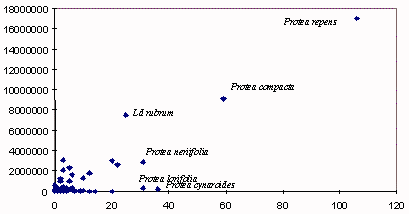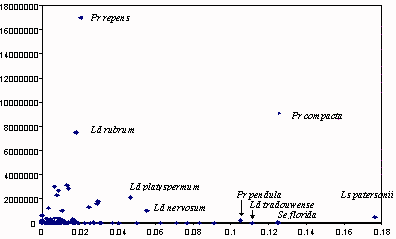
Home
Mission
Overview of Project
Project Staff
Sponsors
Achievements
Checking, Illustrations
Upcoming Activities
Id and Species Lists
Protea Information
Protea Gallery
Growing Proteas
Interim Dist. Maps
Publications
Afrikaanse Inligting
![]()
Picking of Proteas
One of the fields on the Sight Record Sheet is for noting whether species are picked or not. You may enter either: blank (don't know, didn't look), "N" for No or Nothing, "R" for Rare picking, or "S" for Severe picking. Not everyone makes use of the codes, but for those that do bother, very many thanks.
SAPPEX (the South African Protea Producers and Exporters association) commissioned in 1984 a survey of the indigenous Ornamental Flower Industry, one aspect of which was determining which species were picked and how much was picked. This was published last year and provided an excellent opportunity to compare atlasser's data with that provided by the industry. A report on the "Utilization of Proteas", using atlas data was presented to SAPPEX in recognition for SAPPEX's contribution to the Protea Atlas Project, both in donations of money and in general support. A copy is available at the office for perusal.
Briefly, we discovered that the industry data was inadequate. We picked up one species Ld album which is heavily picked, but was not reported as used by the industry. We also picked up very heavy utilization of some localized and rare species, as well as picking in the wild of species reportedly only picked from protea orchards. In addition, a fair number of species were not recorded as picked, escaping detection by being traded as "greens." Another problem is that trade names are usually old Latin species names, and that this can cause confusion, for example, Salignum is now Ld xanthoconus and Glabrum is used for several current species (not just Ld gandogeri).
We also discovered that the Protea Atlas data was inadequate. Atlassers tended not to record picking from species with hidden flowers, species which were only picked in a localized area, or species picked at low levels of intensity. And of course, very few (there are some!) atlassers have recorded which species are being grown and picked in orchards. Most importantly, Protea Atlas data are heavily biased towards recording picking from species which are rare. This is perfect for conservation purposes, but does not reflect the true focus of the industry on the few most popular and lucrative species, which account for the vast bulk of material sold.
All in all, over one third (123 out of 374) of our proteas have been used by the industry. Atlassers have recorded picking from 92 species, compared to 67 recorded by the industry. Of these, both data sets included 51 species. A further 15 species, which have been recorded in the past as picked, were not noted as picked in either data set. Thus atlassers have failed to identify 16 species which are currently picked (but many of these are from orchards) and the industry missed 36 species (excluding the non-Cape region which was not included in the industry survey, for which we have 5 additional species recorded as picked).
Figure 1. The number of stems recorded as picked by the Fynbos ornamental Industry

We hope our data proves useful to SAPPEX. An independent evaluation of surveys is a useful tool for determining the adequacy and pitfalls of methods used. We note that there is a good congruence between both data sets in detail (see graphs opposite), but hope that future industry surveys will be more comprehensive (especially regarding the species content of "Greens").

Of course, this is only the start. We can produce updates of our data at any time. However, our data are only as good as you, the atlasser, provides. Please keep your beady eye open for any sign of picking and fill in the data on your SRS. And thank you for the excellent data to date!
The following species are plucked commercially, but have not been recorded as such by atlassers:
Ha sericea
Ld argenteum
Ld galpinii
Ld sessile
Ld uliginosum uliginosum
Ls conocarpodendron viridum
Ls erubescens
Ls glabrum
Pa spathulatus
Pr cordata
Pr glabra
Pr lanceolata
Pr pityphylla
Pr recondita
Pr scolymocephala
Pr sulphurea
We have also had no luck with starting a survey of species available at road stalls and supermarkets. A copy of the form for this purpose is available from the office, or can be copied from PAN 20: 16.
Please help!
Have a look at more Protea Picking statisitics and a severe case of Common Sugarbush - Protea caffra caffra hacking.